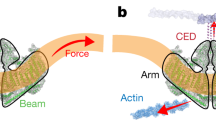Abstract
The bending stiffness of a phospholipid bilayer (kc) was measured by forming thin bilayer cylinders (tethers) from giant phospholipid vesicles. Based on the balance of forces, the tether force was expeeted to be proportional to the square root of the membrane tension, with a constant of proportionality containingk>c. The membrane tension was controlled via the aspiration pressure in a micropipette used to hold the vesicle. The force on the tether was generated by an electromagnet acting on a paramagnetic bead attached to the vesicle surface. The magnitude of the force was determined from measurements on the magnet current which was adjusted to maintain the position of the bead. Measurements were performed on vesicles composed of stearoyl-oleoyl-phosphatidylcholine plus 5% (by mole) biotinylated phosphatidylethanolamine to mediate adhesion to streptavidin-coated beads. From each vesicle, tethers were formed repeatedly at different values of the membrane tension. The expected relationship between membrane tension and tether force was observed. The mean value ofkc for 10 different vesicles was 1.17×10−19 J (SD=0.08×10−19 J). The precision of these data demonstrates the reliability of this approach, which avoids uncertainties of interpretation and measurement that may be associated with other methods for determiningkc.
Similar content being viewed by others
References
Angelova, M. I., S. Soléau, Ph. Méléard, J. F. Faucon, and P. Bothorel. Preparation of giant vesicles by external AC electric fields. Kinetics and applications.Prog. Colloid. Polym. Sci. 89:127–131, 1992.
Ashkin, A., and J. M. Dziedzic. Optical trapping and manipulation of viruses and bacteria,Science 235:1517–1520, 1987.
Bo, L., and R. E. Waugh. Determination of bilayer membrane bending stiffness by tether formation from giatn, thin-walled vesicles,Biophys. J. 55:509–517, 1989.
Božič, B., S. Svetina, B. Žekš, and R. E. Waugh. The role of lamellar membrane structure in tether formation from bilayer vesicles,Biophys. J. 61:963–973, 1992.
Döbereiner, H.-G., E. Evans, U. Seifert, and M. Wortis. Spinodal fluctuations of budding vesicles,Phys. Rev. Lett. 75:3360–3363, 1995.
Evans, E. A. Minimum energy analysis of membrane deformation applied to pipet aspiration and surface adhesion of red blood cell,Biophys. J. 30:265–284, 1980.
Evans, E., and D. Needham. Physical properties of surfactant bilayer membranes: Thermal transitions, elasticity, rigidity, cohesion, and colloidal interactions,J. Phys. Chem. 91:4219–4228, 1987.
Evans, E., and W. Rawicz. Entropy-driven tension and bending elasticity in condensed-fluid membranes,Phys. Rev. Lett. 64:2094–2097, 1990.
Evans, E., K. Ritchie, and R. Merkel. Sensitive force technique to probe molecular adhesion and structural linkages at biological interfaces,Biophys. J. 68:2580–2587, 1995.
Evans, E. A., and R. Skalak. Mechanics and thermodynamics of biomembranes,CRC Crit. Rev. Bioeng. 3:181–418, 1979.
Evans, E., and A. Yeung. Hidden dynamics in rapid changes of bilayer shape.Chem. Phys. Lipids 73:39–56, 1994.
Evans, E., A. Yeung, R. Waugh, and J. Song. Dynamic coupling and nonlocal curvature elasticity in bilayer membranes. In:The Structure and Conformation of Amphiphilic Membranes, edited by R. Lipowsky, D. Richter, and K. Kremer, Berlin, Heidelberg: Springer-Verlag, 1992, pp. 148–153.
Faucon, J. F., M. D. Mitov, P. Meleard, I. Bivas, and P. Bothorel. Bending elasticity and thermal fluctuations of lipid membranes. Theoretical and experimental requirements.J. Phys. France 50:2389–2414, 1989.
Guilford, W. H., and R. W. Gore. A novel remote-sensing isometric force transducer for micromechanics studies.Am. j. Physiol. 263:C700-C707, 1992.
Guilford, W. H., R. C. Lantz, and R. W. Gore. Locomotive forces produced by single leukocytes in vivo and in vitro.Am. J. Physiol. 268:C1308-C1312, 1995.
Heinrich, V., M. Brumen, R. heinrich, S. Svetina, and B. Žekš. Nearly spherical vesicle shapes calculated by use of spherical harmonics: Axisymmetric and nonaxisymmetric shapes and their stability.J. Phys. France 2:1081–1108, 1992.
Heinrich, V., S. Svetina, and B. Žekš. Nonaxisymmetric vesicle shapes in a generalized bilayer-couple model and the transition between oblate and prolate axisymmetric shapes.Phys. Rev. E 48:3112–3123, 1993).
Helfrich, W. Tension-induced mutual adhesion and a conjectured superstructure of lipid membranes. In:Handbook of Biological Physics, Vol. 1. edited by R. Lipowsky, and E. Sackmann, Amsterdam, Elsevier Science B.V., 1995, pp. 691–721.
Lipowsky, R. The conformation of membranes,Nature 349:475–481, 1991.
McIntosh, T. J., and S. A. Simon. Hydration force and bilayer deformation: A reevaluation,Biochemistry 25:4048–4066, 1986.
Needham, D., and R. S. Nunn. Elastic deformation and failure of lipid bilayer membranes containing cholesterol.Biophys. J. 58:997–1009, 1990.
Niggemann, G., M. Kummrow, and W. Helfrich. The bending rigidity of phosphatidylcholine bilayers: Dependences on experimental method, sample cell sealing and temperature,J. Phys. France 5:413–425, 1995.
Reeves, J. P., and R. M. Dowben. Formation and properties of thin-walled phospholipid vesicles,J. Cell. Physiol. 73:49–60, 1969.
Sackmann, E. Physical basis of self-organization and function of membranes: Physics of vesicles. In:Handbook of Biological Physics, Vol. 1. edited by R. Lipowsky and E. Sackmann. Amsterdam: Elsevier Science B.V., 1995, pp. 213–304.
Seifert, U., K. Berndl, and R. Lipowsky. Shape transformation of vesicles: Phase diagram for spontaneous-curvature and bilayer-coupling models,Phys. Rev. A 44: 1182–1202, 1991.
Schneider, M. B., J. T. Jenkins, and W. W. Webb. Thermal fluctuations of large cylindrical phospholipid vesicles.Biophys. J. 45:891–899, 1984.
Servuss, R. M., W. Harbich, and W. Helfrich. Measurement of the curvature-elastic modulus of egg lecithin bilayers.Biochim. Biophys. Acta 436:900–903, 1976.
Song, J. B., and R. E. Waugh. Bending rigidity of SOPC membranes containing cholesterol—brief communication.Biophys. J. 64:1967–1970, 1993.
Svetina, S., and B. Žekš. Elastic properties of closed bilayer membranes and the shapes of giant phospholipid vesicles. In:Handbook of Nonmedical Applications of Liposomes, Vol. 1, edited by D. D. Lasic, and Y. Barenholz. Boca Raton, New York, London, Tokyo: CRC Press, 1996, pp. 13–42.
Waugh, R. E., and R. M. Hochmuth. Mechanical equilibrium of thick hollow liquid membrane cylinders,Biophys. J. 52:391–400, 1987.
Waugh, R. E., J. Song, S. Svetina, and B. Žekš. Monolayer coupling and curvature elasticity in bilayer membranes by tether formation from lecithin vesicles.Biophys. J. 61: 974–982, 1992.
Author information
Authors and Affiliations
Rights and permissions
About this article
Cite this article
Heinrich, V., Waugh, R.E. A piconewton force transducer and its application to measurement of the bending stiffness of phospholipid membranes. Ann Biomed Eng 24, 595–605 (1996). https://doi.org/10.1007/BF02684228
Received:
Accepted:
Issue Date:
DOI: https://doi.org/10.1007/BF02684228




